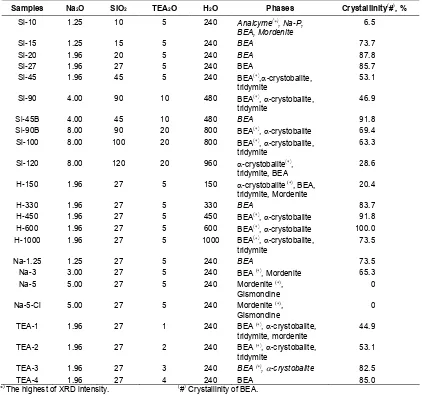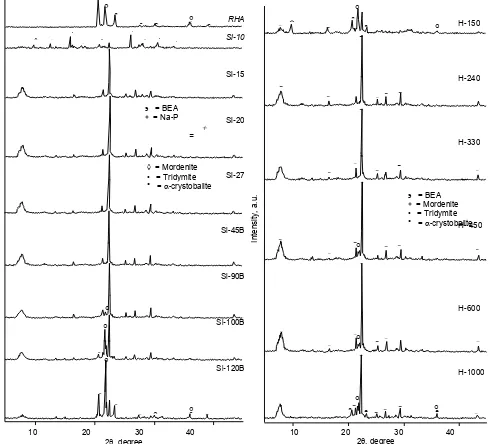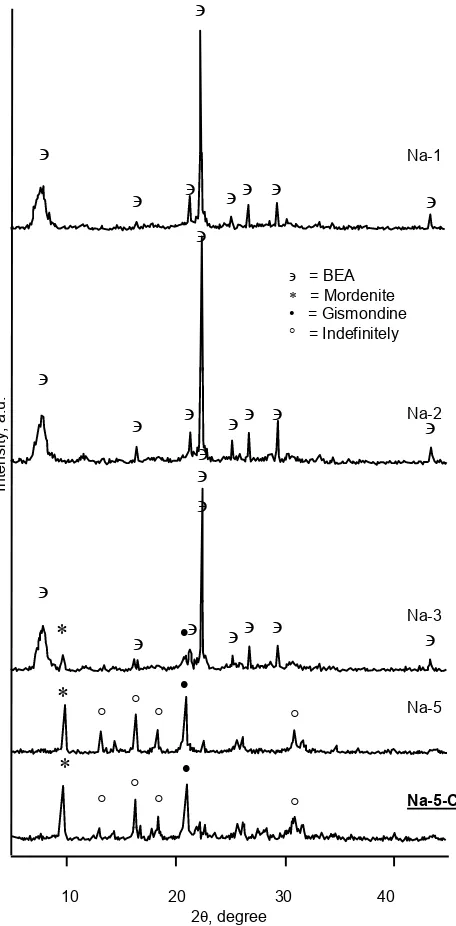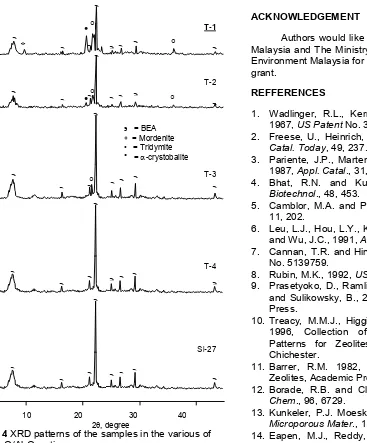* Corresponding author.
SYNTHESIS OF ZEOLITE BETA DIRECTLY FROM RICE HUSK ASH: EFFECT OF
REACTION COMPOSITION ON CRYSTALLINITY OF ZEOLITE BETA
Didik Prasetyoko
a,*, Zainab Ramli
a, Salasiah Endud
a, Halimaton Hamdan
band Bogdan Sulikowski
ca
Department of Chemistry, Faculty of Science, Universiti Teknologi Malaysia, 81310 Johor, Malaysia
b
Ibnu Sina Insitute for Fundamental Science Studies, Universiti Teknologi Malaysia, 81310 Johor, Malaysia
c
Institute of Catalysis and Surface Chemistry, Polish Academy of Sciences, Niezapominajek 8, 30-239 Cracow,Poland
Received 29 December 2005; Accepted 10 January 2006
ABSTRACT
White rice husk ash obtained from complete uncontrolled burning of rice husk contains more than 94% silica. The ash, which consists of crystalline silica of the type tridymite and -crystobalite, was used directly as a source of silica in the synthesis of zeolite beta. The mole oxide ratio of the initial gel of 1.25-8Na2O: 10-120SiO2:
Al2O3: 1-20TEA2O: 150-1000H2O was prepared and heated at 150C in a static condition for 6 d. The solid phases
formed were monitored by XRD technique. Influence of reaction mixture ratio in the initial gel to the crystalline products formed was studied. Results showed that the pure zeolite beta was formed in a certain range of reaction mixture, i.e.: 1.25-4Na2O : 15-45SiO2 : Al2O3 : 4-10TEA2O : 240-480H2O. The other ratio of reaction mixtures
produced crystalline phases such as analcime, Na-P, mordenite, and gismondine, and non-reacted of-crystobalite and tridymite.
Keywords:rice husk ash, tridymite,-crystobalite, zeolite beta, synthesis.
INTRODUCTION
Zeolite beta (BEA) was synthesized for the first time by Wadlinger et al. [1] in 1967. It is potentially acid catalysts in the various organic reactions such as alkylation, acylation, epoxidation, and other hydrocarbon reactions. In the acylation of aromatic compounds, zeolite beta showed high activity compare to zeolite Y and ZSM-5 [2]. It is because zeolite beta has three-dimensional twelve-membered ring channels and high strength of acidic sites.
Various types of commercial silica have been used as source of silica in the synthesis of zeolite beta, such as colloidal silica, tetraethylorthosilicate, amorphous aluminosilicate, aerogel, silica gel, and amorphous silica from rice husk ash [1,3-8]. Recently, we have successfully synthesized zeolite beta directly from rice husk ash-containing crystalline silica [9]. In this present paper, we report a study on influence of initial reaction mixture in the formation of zeolite beta.
EXPERIMENTAL SECTION
Synthesis of zeolite beta
The reaction mixture was prepared at room temperature with the appropriate amount of reagents. A certain amount of the rice husk ash (94 wt% SiO2) was added to the aqueous solution of sodium hydroxide (Merck) in the Teflon beaker (mixture A). Sodium
aluminate (54% Al2O3: 41% Na2O, wt%, technical grade) was dissolved in the Tetraethyl ammonium hydroxide, TEAOH solution (40% TEAOH in water, supplied by Fluka chimika), which was previously diluted with a small amount of water (solution B). Solution B was added slowly to the mixture A with vigorous stirring and homogenized for at least 2 h. The mixture obtained was transferred to a stainless steel autoclave, and heated at 150 oC under autogeneous pressure for 6 d. After hydrothermal crystallization, the solid was separated from the mixture by filtering and washing by distilled water until neutral. Finally, the solid was dried at 110 °C overnight. To study the influences of the composition of reaction mixture, synthesis of zeolite beta has been carried out in various ratios of reactants (Table 1).
Characterization
Table 1Summary of data the reaction mixture (oxide mole ratio, based on 1 mole of Al2O3), contained phases, and crystallinity of zeolite beta obtained.
Samples Na2O SiO2 TEA2O H2O Phases Crystallinity
(
#), %
Si-10 1.25 10 5 240 Analcyme(), Na-P, BEA, Mordenite
6.5
Si-15 1.25 15 5 240 BEA 73.7
Si-20 1.96 20 5 240 BEA 87.8
Si-27 1.96 27 5 240 BEA 85.7
Si-45 1.96 45 5 240 BEA(),-crystobalite, tridymite
53.1 Si-90 4.00 90 10 480 BEA(),-crystobalite,
tridymite
46.9
Si-45B 4.00 45 10 480 BEA 91.8
Si-90B 8.00 90 20 800 BEA(),-crystobalite 69.4 Si-100 8.00 100 20 800 BEA(),-crystobalite,
tridymite
63.3 Si-120 8.00 120 20 960 -crystobalite(),
tridymite, BEA
28.6 H-150 1.96 27 5 150 -crystobalite(), BEA,
tridymite, Mordenite
20.4
H-330 1.96 27 5 330 BEA 83.7
H-450 1.96 27 5 450 BEA(),-crystobalite 91.8 H-600 1.96 27 5 600 BEA(),-crystobalite 100.0 H-1000 1.96 27 5 1000 BEA(),-crystobalite,
tridymite
73.5
Na-1.25 1.25 27 5 240 BEA 73.5
Na-3 3.00 27 5 240 BEA(), Mordenite 65.3 Na-5 5.00 27 5 240 Mordenite(),
Gismondine
0 Na-5-Cl 5.00 27 5 240 Mordenite(),
Gismondine
0 TEA-1 1.96 27 1 240 BEA(),-crystobalite,
tridymite, mordenite
44.9 TEA-2 1.96 27 2 240 BEA(),-crystobalite,
tridymite
53.1 TEA-3 1.96 27 3 240 BEA(),-crystobalite 82.5
TEA-4 1.96 27 4 240 BEA 85.0
(
*)The highest of XRD intensity. (#)Crystallinity of BEA.
RESULT AND DISCUSSION
Influence of Silica
Fig. 1 shows XRD patterns of the solid product resulted from various SiO2/Al2O3ratio and also a source of silica (rice husk ash). Difractogram of rice husk ash (Fig. 1 RHA) show the peaks at 2: 20.6o, 21.8o, 23.4o, 27.7o, 30.2, 36.2o, 39.0oand 21.9o, 31.4o, 36.2o, conform that the sample contains crystalline silica of tridymite and
-crystobalite [10]. In addition, no hump at 2: 15o- 30o indicates that sample does not contain or maybe contain low amount of an amorphous phase.
Based on XRD results, generally, pure zeolite beta may be prepared by using certain initial reaction mixture, i.e. at SiO2/Al2O3 mol ratio = 15 – 45. The XRD data show that crystallinity of pure zeolite beta (sample Si-15, Si-20, Si-27 and Si-45B) increase as increasing of SiO2/Al2O3 ratio, from 73.7% for sample Si-15 to 91.8%
for sample Si-45B. Meanwhile, for sample with higher SiO2/Al2O3 ratio (Si-90B, Si-100B and Si-120B), the zeolite beta crystallinity decrease up to 28.6% (sample Si-120B). These finding show that the number of mole silica in the reaction mixture effect in the growing process of the zeolite beta crystal.
At low silica content (SiO2/Al2O3 = 10), the products are zeolite beta, analcime, Na-P and mordenite with low crystallinity. The other three types of zeolites usually are formed in the synthesis of zeolite at low SiO2/Al2O3 ratio and high alkalinity of reaction mixture [11]. The formation of that zeolites in the preparation of zeolite beta has been reported [3,12,13]. These show that pure zeolite beta cannot be prepared at SiO2/Al2O3ratio of 10.
are used for synthesis of zeolite beta with higher SiO2/Al2O3 ratio (only addition of silica), such as sample Si-45 and Si-90, the solid product is zeolite beta but an amount of rice husk ash was not reacted. However, there is no evident of another zeolite phase show that pure zeolite beta can be prepared at high content of silica. Crystallinity of zeolite beta phase in the sample Si-45 is higher than that of sample Si-90, while crystallinity of tridymite and -crystobalite in the sample Si-45 is lower than that in sample Si-90. This indicates that as the silica content increases, the amount of tridymite and
-crystobalite reacted decrease, therefore, zeolite beta resulted also decreases. It is due to the alkalinity of the reactant mixture that is not enough to dissolve the silica
Fig. 1XRD patterns of the samples in the various of
SiO2/Al2O3ratio
added. This statement was supported by the data of sample Si-45B. At this mixture, all of rice husk ash was reacted to form zeolite beta. Meanwhile, at SiO2/Al2O3 ratio = 90 (sample Si-90B), the main product was zeolite beta with high crystallinity, although not all of rice husk ash reacted. For sample Si-100B, the products were zeolite beta and high crystallinity of non-reacted rice husk ash. As increasing of silica content, the crystallinity of zeolite beta formed further decreased, inversely the crystallinity of rice husk ash increased, in which the peak intensity of tridymite was lower than -crystobalite. These show that the mole of Na2O, TEA2O and H2O affected the dissolution of silica rice husk ash, consequently, also the formation of
Fig. 2XRD patterns of the samples in the various of
the H2O/Al2O3ratio ° =-crystobalite
° =-crystobalitezeolite beta. In addition, it could be concluded that tridymite dissolved easier than -crystobalite in the reactant mixture of synthesis of zeolite beta.
Influence of H2O
Fig. 2 shows XRD patterns for solids prepared with various H2O/Al2O3 ratios. The pure zeolite beta can be prepared by using reaction mixture of sample H-240 and H-330. By decreasing H2O content (sample H-150), non-reacted rice husk ash was still present with high crystallinity, although zeolite beta also could be formed in this reaction mixture. In addition, a trace of mordenite also appears in the solid. The formation of mordenite during synthesis of zeolite beta with H2O/Al2O3 ratio about 200 has been reported [11,12]. It is due to the low amount of H2O (high ratio of solid to liquid phase) that suppress of the monomer combination process in the nucleation of zeolite beta. As increasing of the water amount, the solid product are zeolite beta and non-reacted rice husk ash, in which the crystallinity of zeolite beta increase with mole of H2O increase (H2O/Al2O3 = 450 and 600), and then continue decrease for the sample with H2O/Al2O3 ratio = 1000. Meanwhile, increasing of water amount affect of the dissolution rice husk ash, in which only-crystobalite exist in the sample H-450 and H-600, while tridymite and-crystobalite exist in the sample H-1000. These show that dissolution of the rice husk ash depend on the concentration of base in the reaction mixture.
Dissolution of RHA is slowly progress as increasing of water content that cause low rate of nucleation/degree of crystallization, as a results, longer time in the formation of zeolite beta. We have reported that zeolite beta starts to form after 2 d of crystallization for sample H-600 [9]. However,-crystobalite still exists up to 6 d of crystallization time. While, for H-240, zeolite beta was already formed after 12 h of crystallization time (XRD data not shown). By addition of water, the rate of nucleation and crystal growth decreases as the reaction concentration decreases. Although the rate of crystal growing is slower, the XRD results indicate that the crystal is well form for sample H-600 (100% crystallinity) compare to sample H-240 (81.6% crystallinity).
Influence of Sodium
Fig. 3 shows XRD patterns of the samples in the various sodium contents. The result concludes that the pure zeolite beta obtained by using low concentration of sodium (sample Na-1 and Na-2). Mordenite and gismondine will be formed as an addition of sodium. Moreover, sample Na-5-Cl and Na-5 (same of sodium content but different of hydroxide content) results the same type of crystal (mordenite and gismondine). These finding show that the formation of mordenite and gismondine are not because of the hydroxide, but because of sodium. These results were not agree with
result reported by Camblor and Pariente [5] in the synthesis zeolite beta using silica amorphous as source of silica. In the range of reaction mixture: 0-4.5 Na2O : 1 Al2O3: 50 SiO2 : 12.5 TEA2O : 750 H2O, only zeolite beta was formed. The formation of mordenite may be caused by high ratio of sodium to water (ratio of Na+/H2O of sample Na-5 = 0.0208, and Na-3 = 0.0125). In addition, sample H-150 (ratio of Na+/H2O = 0.0131) also gives mordenite as impurities phase. Mordenite and ZSM-5 phases have been found in the preparation of zeolite beta in the high alkalinity condition [14].
Fig. 3XRD patterns of the samples in the various of
Influence of template
XRD patterns in Fig. 4 shows that pure zeolite beta can be prepared by using reaction mixture with ratio of TEA2O/Al2O3 > 3.0. Crystallinity increases as the number of template increases, and become constant at TEA2O/Al2O3 ratio higher than 2.0. Decreasing of TEA2O/Al2O3 ratio produces zeolite beta and mordenite with non-reacted rice husk ash. These show that template not only act as structure directing agent, but also takes into account in the dissolution of rice husk ash. It is because template TEAOH has base property.
For sample with ratio of TEA2O/Al2O3= 1, zeolite beta was formed with mordenite. It may be formed because the gel contains both template TEA+ and sodium cations that compete in building the zeolite structure. The formation of mordenite may be caused by
Fig. 4XRD patterns of the samples in the various of
TEA2O/Al2O3ratio
the low amount of template TEA+and the presence of sodium ion induces to the formation of zeolite with mordenite structure. This shows that template is important in the formation of zeolite beta. Leu et al. [6] in the synthesis of zeolite beta using colloidal silica as a source of silica found that formation of zeolite beta is started at the ratio of TEA2O/Al2O3 = 0.8, and gives good crystallinity at the ratio of TEA2O/Al2O3= 2.0.
CONCLUSION
Composition of initial reaction mixture may influence the crystallinity of zeolite beta. Zeolite beta may only be prepared in the certain ratios of reaction mixture. Water and pH of the reaction mixture influence the dissolution of rice husk ash, while alkalinity does not.
ACKNOWLEDGEMENT
Authors would like to thank Universiti Teknologi Malaysia and The Ministry of Science Technology and Environment Malaysia for financial support, under IRPA grant.
REFFERENCES
1. Wadlinger, R.L., Kerr, G.T., and Rosinski, E.J., 1967,US PatentNo. 3308069.
2. Freese, U., Heinrich, F., and Roessner, F., 1999, Catal. Today, 49, 237.
3. Pariente, J.P., Martens, J. A., and Jacobs, P. A., 1987,Appl. Catal., 31, 35.
4. Bhat, R.N. and Kumar, R. J., 1990, Chem. Biotechnol., 48, 453.
5. Camblor, M.A. and Pariente, J.P., 1991, Zeolites, 11, 202.
6. Leu, L.J., Hou, L.Y., Kang, B.C., Li, C.L., Wu, S.T. and Wu, J.C., 1991,Appl. Catal. A., 69, 49.
7. Cannan, T.R. and Hinchey, R.J., 1992, US Patent No. 5139759.
8. Rubin, M.K., 1992,US PatentNo. 5164170.
9. Prasetyoko, D., Ramli, Z., Endud, S., Hamdan, H. and Sulikowsky, B., 2006, Waste Management, in Press.
10. Treacy, M.M.J., Higgins, J.B. and von Ballmoos, 1996, Collection of Simulated XRD Powder Patterns for Zeolites, John Wiley and Sons, Chichester.
11. Barrer, R.M. 1982, Hydrothermal Chemistry of Zeolites, Academic Press, New York.
12. Borade, R.B. and Clearfield, A., 1992, J. Phys. Chem., 96, 6729.
13. Kunkeler, P.J. Moeskops, D. Bekkum, H.V. 1997, Microporous Mater., 11, 313.
14. Eapen, M.J., Reddy, K.S.N. and Shirakar, V.P., 1994,Zeolites, 14, 295.
10 20 30 40 ° =-crystobalite



